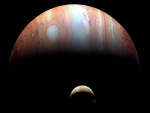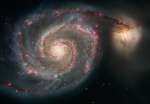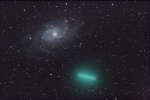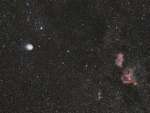
|
Astronomy Picture Of the Day (APOD)
 A Jupiter Io Montage from New Horizons
A Jupiter Io Montage from New Horizons
7.01.2008
As the New Horizons spacecraft sweeps through the Solar System, it is taking breathtaking images of the planets. In February of last year, New Horizons passed Jupiter and the ever-active Jovian moon Io. In this montage, Jupiter was captured in three bands of infrared light making the Great Red Spot look white.
 Quadrantid Meteors and Aurora from the Air
Quadrantid Meteors and Aurora from the Air
6.01.2008
Where do meteor showers originate? To help answer this question, astronomers studied in some detail the Quadrantid meteor shower that occurred over this past weekend. In particular, astronomers with specialized cameras flew as part...
 Jupiters Rings Revealed
Jupiters Rings Revealed
5.01.2008
Why does Jupiter have rings? Jupiter's rings were discovered in 1979 by the passing Voyager 1 spacecraft, but their origin was a mystery. Data from the Galileo spacecraft that orbited Jupiter from 1995 to 2003 later confirmed that these rings were created by meteoroid impacts on small nearby moons.
 M51: Cosmic Whirlpool
M51: Cosmic Whirlpool
4.01.2008
Follow the handle of the Big Dipper away from the dipper's bowl, until you get to the handle's last bright star. Then, just slide your telescope a little south and west and you might find this stunning pair of interacting galaxies, the 51st entry in Charles Messier's famous catalog.
 The Milky Way at 5000 Meters
The Milky Way at 5000 Meters
3.01.2008
Climb up to 5000 meters (16,500 feet) above sea level, near Cerro Chajnantor in the northern Chilean Andes, and your night sky could encompass this cosmic vista. Recorded from that high and dry locale, the spectacular fish-eye image features the myriad stars and sprawling dust clouds of our Milky Way Galaxy.
 Geminids in 2007
Geminids in 2007
2.01.2008
Dust from curious near-Earth asteroid 3200 Phaethon seems to fall from the constellation Gemini in this fisheye skyview. The composite image was recorded over four December nights (12-15) just last year from Ludanyhalaszi, Hungary. Of course, the streaks are meteor trails from the annual Geminids meteor shower.
 APOD: 2008 January 2- A Galaxy is not a Comet
APOD: 2008 January 2- A Galaxy is not a Comet
1.01.2008
This gorgeous galaxy and comet portrait was recorded on December 30th, in the skies over Hoogeveen, The Netherlands. The combined series of 60 x 60 second exposures finds the lovely green coma of Comet 8P/Tuttle near its predicted conjunction with the Triangulum Galaxy.
 APOD: 2008 January 1- Rays from an Unexpected Aurora
APOD: 2008 January 1- Rays from an Unexpected Aurora
31.12.2007
This aurora was a bit of a surprise. For starters, on this day in 2002, no intense auroral activity was expected at all. Possibly more surprising, however, the aurora appeared to show an usual structure of green rays from some locations.
 A Year of Spectacular Comets
A Year of Spectacular Comets
30.12.2007
Two spectacular comets graced Earth's skies during 2007. Both comets became bright enough to be seen by the unaided eye of the casual sky enthusiast. Early in 2007, Comet McNaught grew brighter than any comet in 40 years, displaying a beautiful dust tail that flowed across the sky.
 Mammatus Clouds Over Mexico
Mammatus Clouds Over Mexico
29.12.2007
Normal cloud bottoms are flat because moist warm air that rises and cools will condense into water droplets at a very specific temperature, which usually corresponds to a very specific height. After water droplets form that air becomes an opaque cloud.
|
January February March April May June |
||||||||||||||||||||||||||||||||||||||||||||||||||||||||